Panniculitis
What is Panniculitis?
Panniculitis is the inflammation of the fat and connective tissue that lies underneath our skin.
It can also happen in the fatty tissue that surrounds the organs which lies inside our body. The fat under our skin is arranged like a honey comb. The rooms that contain the fat are called lobules and the walls separating the rooms are called as septa. The inflammation can involve either the lobule or the septa or both.
Types of Panniculitis
Panniculitis can be a disease by itself or a manifestation of some underlying disease. Panniculitis is a caused by a broad range of diseases. It is classified based on the part of the fatty tissue involved and the involvement of blood vessels in the inflammation (vasculitis). When the lobule of the fatty tissue is affected it is called lobular panniculitis. When the inflammation is mainly seen in septa, it is called septal panniculitis. But usually there is some extent of damage to both lobule and septa. Thus Panniculitis is broadly classified as : [1, 3, 4]
Lobular Panniculitis
- with vasculitis
- without vasculitis
Septal Panniculitis
- with vasculitis
- without vasculitis
Needle shaped cleft
- lipodermato sclerosis
To know about the list of panniculitis under each type is very tiring and time consuming. It can be referred from www.dermnetnz.org . So let’s know about the type of panniculitis which are more common and of importance. They are
- Erythema nodosum – It is a septal panniculitis and the most common form of panniculitis
- Erythema induratum – It is a lobular panniculitis and is associated with damage to blood vessel
- Mesentric panniculitis – It is the panniculitis of the mesentry which is a fan shaped layer of tissue that fixes the bowels to the body wall. This layer is richly covered with fat
- Lupus panniculitis – Panniculitis caused by systemic lupus erythematosis
- Pancreatic panniculitis – Pancreas is an organ that looks like an American corn and is cushioned by fat globules in the space between its kernels. Inflammation of this fatty tissue is called pancreatic panniculitis
- Cold panniculitis
- Traumatic panniculitis
- Necrotising panniculitis – Any type of panniculitis when becomes severe and leads to destruction of the fatty tissue and result in leaking of oily substances from the lesion, it is called Necrotizing panniculitis. It is mostly associated with pancreatic panniculitis and Panniculitis associated with AT1(Antitrypsin) deficiency [8,9]
Causes of Panniculitis
Panniculitis is caused by a wide range of factors and diseases. But in many cases the cause remains unknown.
General causes of Panniculitis
The various causes of panniculitis are
1. Infections
2. Systemic diseases
3. Trauma
4. Drugs
5. Others
- AT1 deficiency
- Pregnancy
- Autoimmunity – the immune cells of our body identifies the fat cells as foreign cells and starts attacking them
Causes of specific types of Panniculitis
Erythema nodosum
- Infections– TB, Leprosy, Hepatitis C virus, EBV
- Drugs – sulphonamides and OCP
- Inflammatory bowel syndrome
- Cancer
- Pregnancy
- Unknown cause [1, 4]
Erythema induratum
It is an uncommon form of panniculitis that most commonly affects adolescent and menopausal women. It is thought to be an allergic reaction in people with TB but the actual cause for erythema induratum is not known
Traumatic Panniculitis
It is caused by any injury to the parts which are rich in fatty tissue like thigh, breast, and buttocks. The injury causing panniculitis may range from trivial injury like an injection to getting hit on the breast by steering wheel during sudden braking of a vehicle. When the trauma is self inflicted by various methods like injecting oils and chemicals, it is called as factitious panniculitis. [1]
Cold Panniculitis
It is caused by exposure to cold. It is mostly seen in obese women and children during winter. In newborns it is caused by using ice packs. A special type of cold panniculitis that develops in children after sucking Popsicle or ice is called Popsicle panniculitis. [7]
Pancreatic Panniculitis
It is caused by various pancreatic diseases that damage the fat that cushions the pancreas
- Pancreatic cancer – most common cause
- Developmental abnormality in pancreas
- Pseudocyst
- Drug induced
Lipodermatosclerosis
It is a form of panniculitis caused by a long standing varicose vein that causes pooling of blood in the legs. The impure blood that gets pooled in the legs contains chemicals that cause damage to the fatty tissue and the skin over the leg.
Mesentric Panniculitis
Though mesenteric panniculitis is seen more often in people who had abdominal surgeries and abdominal injury, the actual cause is unknown [6]
Symptoms and Pictures of Panniculitis
The symptoms of panniculitis depend on the cause. Each underlying disease present with a group of symptoms specific to it along with the general skin features of Panniculitis. It is very important to identify the symptoms of Panniculitis, as it may be the pointer to a serious underlying disease.
The symptoms of Panniculitis range from mild to life threatening.
1. Panniculitis is most commonly seen in lower legs and other places like thigh, buttocks and chest with more fatty tissue
2. Thickened skin which gives a woody feel on touching
3. Discoloration of the overlying skin may or may not be present
4. Red or dark brown pigmentation of the skin
5. Raised lumps of few mm which are painful
6. Depression in the skin after healing caused by the loss of fat underlying the skin(lipoatrophy)
Associated Symptoms
- Fever
- Weight loss
- Nausea
- Vomiting
- Joint pain
Erythema nodosum
Reddish or dusky blue patch and very painful nodule seen in the shin. On healing, the nodule and the red patch flatten and remain like a bruise without scar.
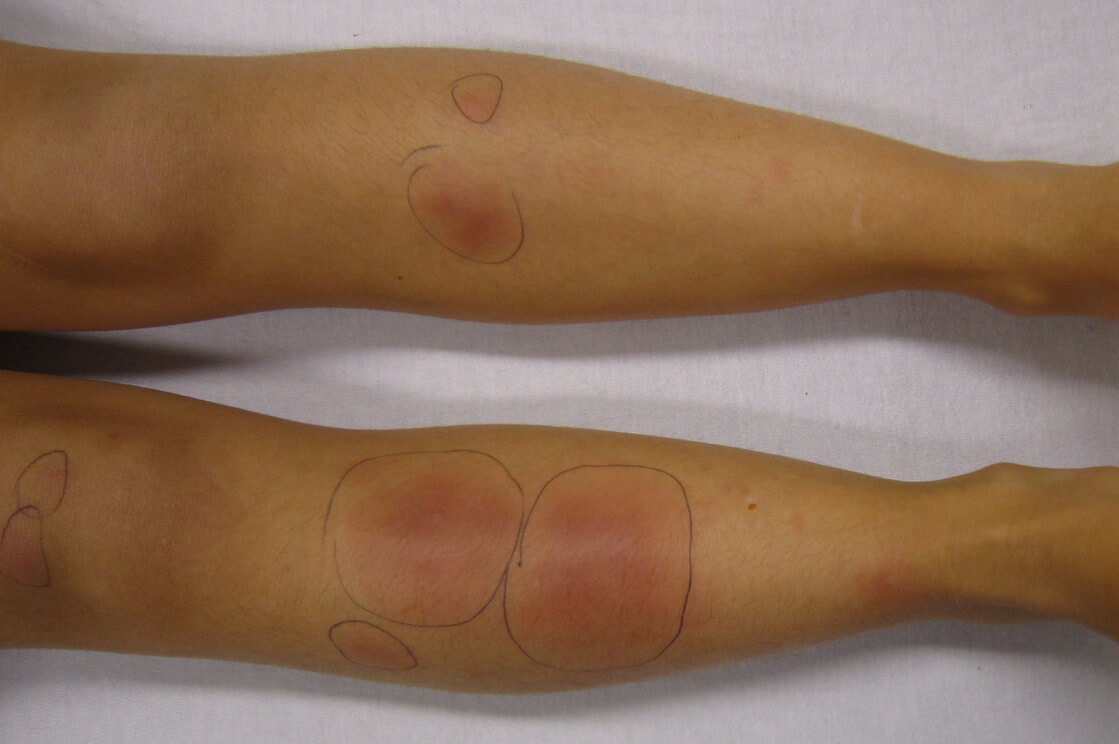
Picture 1: Erythema nodosum in the legs
Image Sorce: http://upload.wikimedia.org/wikipedia/commons/b/bb/ENlegs.JPG
Erythema induratum
Mostly seen in adolescent and menopausal women. It is most commonly seen in calf. Sometimes the nodules break down and form ulcers.
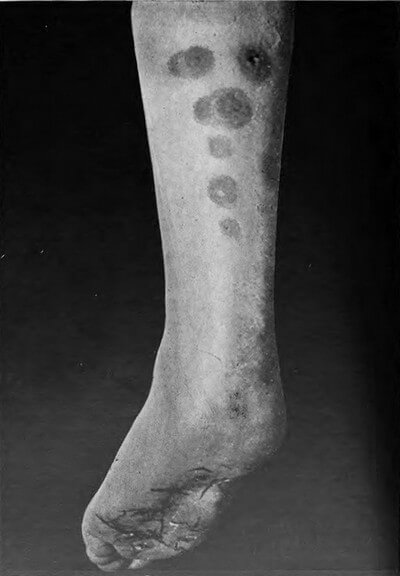
Picture 2: Erythema induratum
Image source: en.wikipedia.org
Cold panniculitis
red or violet nodules are seen which are painful and cold to touch. Mostly seen in cheek and forehead in children and in thighs in obese women [7]
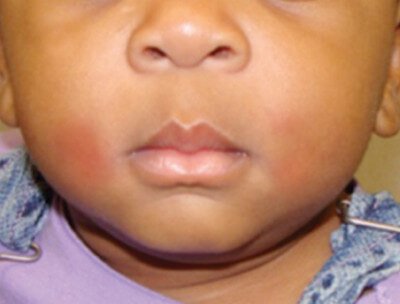
Picture 3: cold panniculitis due to Popsicle
Image source: http://www.pediatricsconsultant360.com/sites/default/files/images/1112CFP_PC_Popsicle.jpg
Pancreatic panniculitis
The panniculitis caused by pancreatic disease present with severe symptom. The panniculitis is painful and causes spontaneous breaking up of the nodules which leaks brown oily substance and an ulcer is formed. Panniculitis which is progressing and is resistant to treatment with associated symptoms of pancreatic disease points to the direction of pancreatic cancer. [9, 10]

Picture 4: Pancreatic panniculitis in a woman with acute pancreatitis
Image source: gastrohep.com
Lipodermatosclerosis
Leathery brown patch which is dry and painful. It is mostly seen in shin and around ankle. When not treated, ulcers are formed which leak fluid and easily get infected.
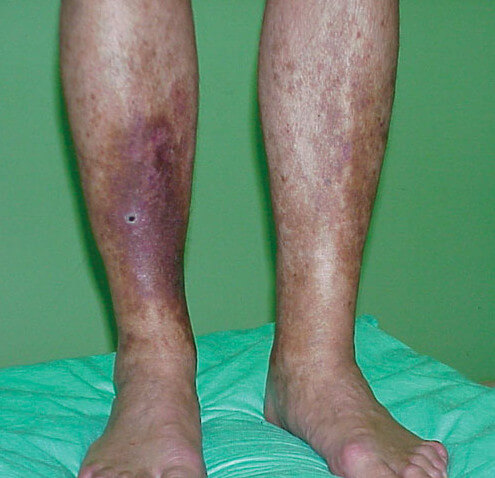
Picture 5: Lipodermatosclerosis due to venous insufficiency
Image source: surgicalnotes.co.uk
Mesenteric panniculitis
- Abdominal discomfort
- Abdominal pain lasting for long duration
- Nausea with or without vomiting
- Bowel habits are normal [6]
Diagnosis of Panniculitis
Diagnosis of panniculitis with the underlying cause is a challenging job because Panniculitis is caused by a wide variety of diseases and in most cases the cause is unknown, the diagnosis can be made successfully by combination of the following
- History of the patient
- Proper clinical examination with emphasis to associated general and systemic symptoms
- Biopsy
- Other investigations when a specific cause is suspected– CT abdomen for mesenteric panniculitis.[6,14]
Treatment of Panniculitis
Panniculitis can be treated successfully if the cause could be found out and each disease has its own treatment protocol. When the cause is not known, treatment is directed to provide symptomatic relief.
- Bed rest
- Keep the legs elevated
- Pain relievers like NSAIDs
- Steroids are useful in most conditions especially mesenteric panniculitis
- Antibiotics for Panniculitis caused by infection
- Withdrawal of medications in drug induced Panniculitis – only after consulting with a physician
- Panniculitis caused by sarcoidosis heals itself after years without treatment.
- Surgery for advanced and irreversible condition – Panniculectomy – Pannus is the fatty tissue that lies like an apron in the body. In uncontrolled and untreatable panniculitis, the Pannus is surgically removed to slow down the progression of disease. But the surgery has its own complications which include post surgical infections. Panniculectomy cannot be done for everyone. There are criteria which have to be fulfilled to find if a patient is ideal candidate for the surgery.
Panniculitis in animals
Panniculitis is also found among animals especially dogs and cats. They have painful nodules which may be red, brown or yellow which breaks up and form ulcers. They crust and then heal. It is most commonly seen in head, neck, chest and abdomen. A veterinarian opinion is necessary regarding the treatment. [11, 12]
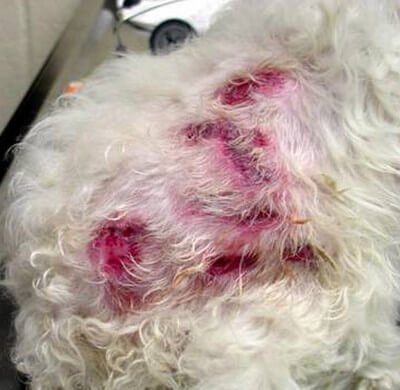
Picture 6: sterile nodular panniculitis in dog
Image source: wikimedia.org
Differential Diagnosis of Panniculitis
1. Subacute panniculitis like T cell lymphoma – It is an aggressive cancer of immune system which cause panniculitis like skin involvement and ulceration[13]
2. Deep fungal infections in immunocompromised people
3. Panniculitis in children [15]
- Weber Christian disease – A group of red nodules seen in the legs of children
- Sclerema neonatarum – presents with cold wooden board like skin in a premature baby. It is a life threatening condition
- Subcutaneous fat necrosis of new born – mildly severe disease with violaceous nodule in a newborn in 2 – 3 weeks of life
- Rapid withdrawal of systemic steroid – firm red patch seen in children of 2 – 14 yrs
4. Lupus erythematosis
5. Mesenteric panniculitis
- Lymphoma
- Desmoids tumor
- Carcinoid tumor [14]
References
- http://en.wikipedia.org/wiki/Panniculitis
- http://www.nejm.org/doi/full/10.1056/NEJM197004232821709
- http://dermnetnz.org/dermal-infiltrative/panniculitis.html
- http://www.nhs.uk/conditions/panniculitis/Pages/Panniculitis.aspx
- http://www.uptodate.com/contents/panniculitis-recognition-and-diagnosis
- http://www.ncbi.nlm.nih.gov/pmc/articles/PMC2726466/
- http://emedicine.medscape.com/article/1082003-overview
- http://alpha-1foundation.org/alpha-1-panniculitis/
- http://www.ncbi.nlm.nih.gov/pubmed/18414166
- http://www.ncbi.nlm.nih.gov/pubmed/23900163
- http://www.vetstreet.com/care/sterile-nodular-panniculitis-in-dogs-and-cats
- http://www.petmd.com/dog/conditions/skin/c_dg_panniculitis
- http://www.ncbi.nlm.nih.gov/pubmed/17934071
- http://www.learningradiology.com/archives2008/COW%20326-Mesentric%20Pannicultis/mesenpancorrect.htm
- http://www.dermatologyrounds.ca/crus/dermeng6_5_07.pdf
Published by Dr. Raj MD under Skin.
Article was last reviewed on August 6th, 2018.

